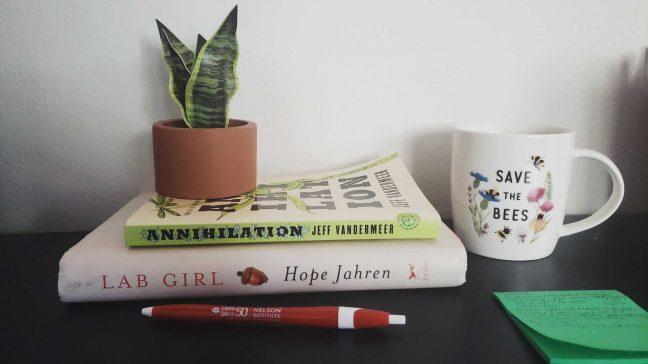Editor’s note: The Lab Report is a weekly series in The Badger Herald’s print edition where we take a deep dive into the (research) lives of students and professors outside the classroom.
University of Wisconsin senior Hailee Morrison has long been interested in using microbes as environmental clean-up solutions, but as she searched for research labs to join this May she was doubtful of any ability to study this as an undergraduate.
Morrison was interested in microbes specifically because many modern scientific techniques were modeled after metabolic processes microbes were already performing.
“That’s why I love microbes so much, a lot of advancements we have made are just us taking what microbes had already figured out and just developing it to use for ourselves,” Morrison said. “Why not use this resource we already have and just tweak it, make it a little better, and use it for the environment.”
When she came across the Majumder lab, which focuses on using microbial mechanisms for environmental health, Morrison jumped in right away on a project with post-doctoral researcher Liyuan (Joanna) Hou.
The project involved using engineered E. coli in an acid whey waste stream. The recombinant, meaning genetic material, was broken up and recombined in a new arrangement. E. coli break down lactose and lactic acid in the acid whey and convert them into a biodegradable plastic polymer, Hou said. Acid whey is a waste product that results from making certain dairy products, which makes it a particularly relevant topic of concern in Wisconsin.

Liuyan (Joanna) Hou/UW Dept. of Bacteriology
Sweet whey, another waste product of dairy production is typically broken down by bacteria into methane, which can be used as an energy source. Such bacteria cannot function in the low pH conditions of acid whey, which means the whey is sometimes neutralized, then converted to methane, a process that is both expensive and impractical for large waste streams, Hou said.
An alternative was to use an acid-tolerant strain of bacteria that would not require neutralization before breaking down the acid whey.
The lab engineered a strain of acid-tolerant E. coli by inserting a plasmid which then allowed the bacteria to convert lactose and lactic acid into a particular biodegradable plastic precursor called polyhydroxybutyrate.
“During the project, we definitely surveyed different parameters, things that really matter to the strain,” Hou said. “Things like initial pH, carbon and nitrogen ratio, lactose and lactic acid ratio and presence of nutrients like trace metals. We tried to see if those factors affected the strain’s PHB production.”

Liuyan (Joanna) Hou/UW Dept. of Bacteriology
Morrison’s role in the project began when it was realized the microbes stopped producing PHB when lactose concentration got too high. The E. coli’s metabolism would actually switch to produce more acid under these conditions, Hou said.
The pathway of producing PHB was being shut down at some point and Morrison tracked enzyme activity to try to figure out where.
The Lab Report: UW researchers explore health, climate change implications of air quality issues
“We were trying to see what enzymes were being inhibited or activated under these conditions and then comparing it against the gene data, so whether a gene was being transcribed at normal, high, or low levels at these conditions,” Morrison said. “We were looking for discrepancies where gene expression is high but enzyme activity is low.”
When that happens, Morrison said they know that something must be repressing production and they need to target that point in the pathway.
Morrison said they did find several points in the pathway where activity was decreased. This led to troubleshooting certain aspects of the measures and acids used in the experiment, which Morrison also contributed to greatly, Hou said.
The experiment found the recombinant E. coli produced an 87% PHB accumulation, which is very impressive compared to other strains. There is still work to be done despite a promising first result, Hou said.

Liuyan (Joanna) Hou/UW Dept. of Bacteriology
The 87% result was based on synthetic wastewater, where the acid whey waste was simulated. In real acid whey, the yield dropped to about 70%. This is likely because of other factors in the waste stream that are not as controlled, Hou said.
“I think the future goal will be to minimize those factors in the real acid whey and to see if they can scale it up because right now it’s only on the lab scale,” Hou said. “But really you want to scale it up to full size to deal with the real problem in the real world.”
Additionally, Hou said engineering the E. coli strain to have the ability to produce other biodegradable plastics besides PHBs could allow the products to have better properties.
Environmental justice approaches paramount in combatting climate change, panel says
Developing plastics that are easier to break down is crucial to protecting our environment, Morrison said. The issue with traditional plastics, Morrison said, is they don’t go away.
“They might break down, they break down into microplastics and nanoplastics, which progressively get more harmful and then they get into the water and into the aquatic life and then we eat the aquatic life and they get into us,” Morrison said. “It’s just bad all around.”
The use of fossil fuels for a one-time use product is also dangerous due to them being a non-renewable energy source. It is much more ideal to cycle the use by creating biodegradable plastics instead, Morrison said.
The process used in this experiment is especially beneficial because it first takes advantage of a waste stream and uses that waste to produce a valuable product that can be widely used, Hou said.


